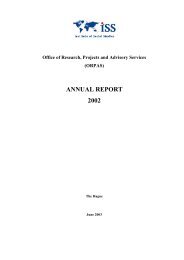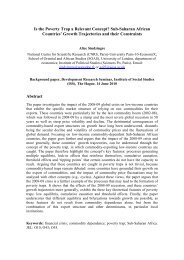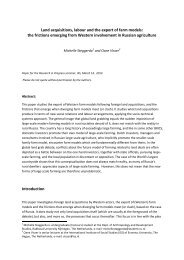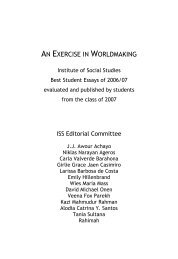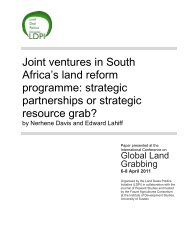AN EXERCISE IN WORLDMAKING 2009 - ISS
AN EXERCISE IN WORLDMAKING 2009 - ISS
AN EXERCISE IN WORLDMAKING 2009 - ISS
You also want an ePaper? Increase the reach of your titles
YUMPU automatically turns print PDFs into web optimized ePapers that Google loves.
206 CH<strong>AN</strong>TELLE DE NOBREGA<br />
Human rights theory has been subject to the claim that human rights<br />
are Western constructs that have no universal applicability or validity,<br />
and they cannot therefore be used to justify state intervention or external<br />
criticism of the way that non-Western government run their countries<br />
and their governments (Marks and Clapham 2004: 387). In addition,<br />
human rights are seen by some as a new form of colonialism and imperialism,<br />
as they represent the West’s desire to impose their values and institutions<br />
on poorer nations, by “recycl[ing] the colonialist project of remaking<br />
the world in [their] image” (Ibid 2004: 387).<br />
The criticism has spilled over into feminist theory, with critics questioning<br />
the ability of feminism and other social movements which use a<br />
human rights approach, to develop universally-applicable theory that is<br />
not imperialistic and ethnocentric (Davis 2008: 9). Davis correctly argues<br />
that feminist theory needs to be inclusive of all women by taking into<br />
account how different women experience oppression depending on<br />
where they are located on the intersectional nexus of relations – but this<br />
needs to be achieved without losing its “theoretical and normative platform”<br />
(2008: 9). Through its emphasis on social context and the multiplicity<br />
of identity, intersectionality offers rights-based feminist theorists a<br />
way to interpret and use context without altogether abandoning the<br />
claim that social relations of power and gender identities lay at the heart<br />
of gender discrimination universally. Thus, intersectionality allows rightsbased<br />
feminist theory to examine “gender through the lens of difference”<br />
(Burgess-Proctor 2006: 35) into complete theoretical and phenomenological<br />
relativism. In other words, intersectionality permits feminists<br />
to retain their emphasis on identity and power without becoming<br />
exclusionary by claiming that they speak to the experience of all women<br />
universally. Feminists are therefore able to avoid rights-based theory<br />
from becoming “obsolete or superfluous” as “there is still work to be<br />
done, and – luckily for all of us – we are the ones to do it” (Davis 2008:<br />
9-10).<br />
C) Intersectionality’s own ethnocentrism in a world of<br />
difference and diversity<br />
Thus far, intersectionality (as a concept) has primarily (but not exclusively)<br />
been discussed and debated in Europe and the United States<br />
(Davis 2008: 3). Given the value that intersectionality can bring to discussions<br />
on human rights theory and praxis, in terms of raising questions




